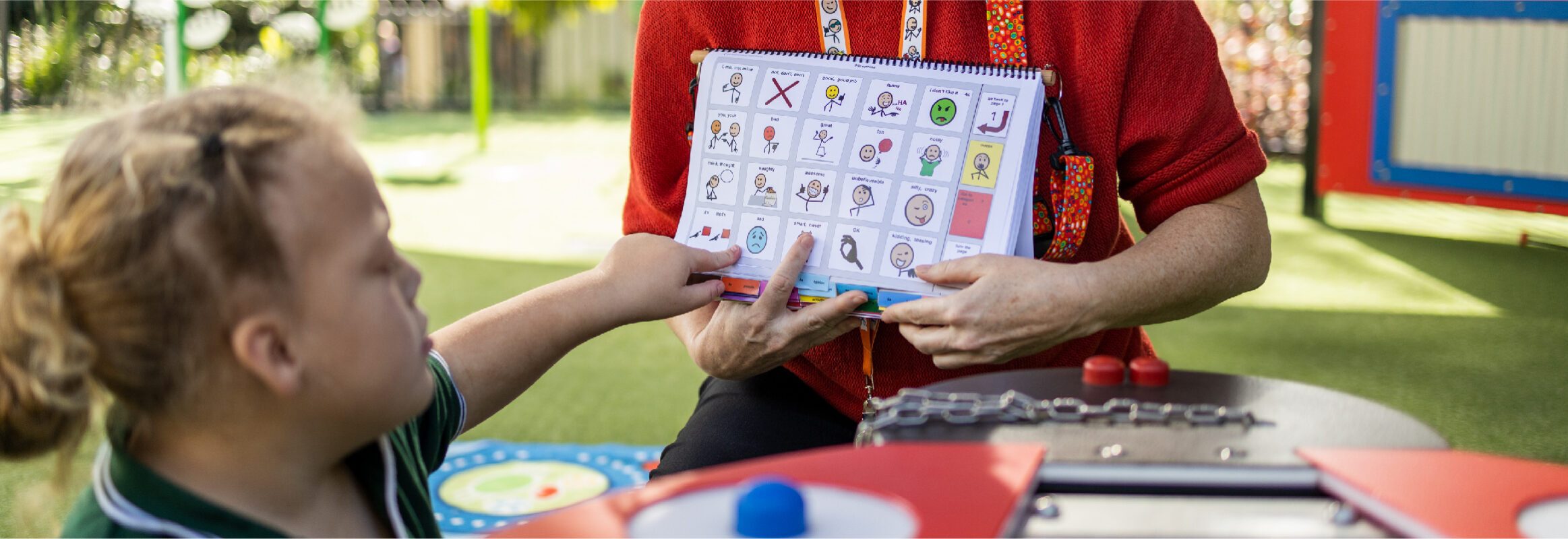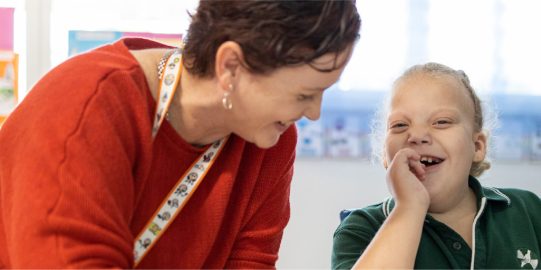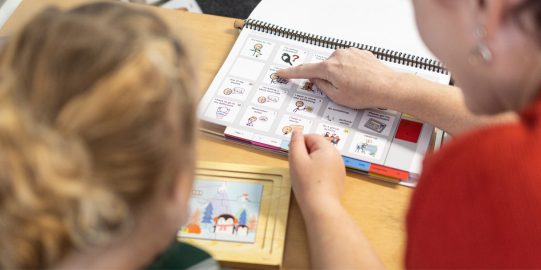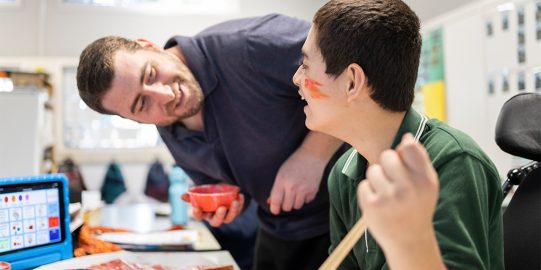Welcome to the next stage in your simPODD journey. By now, you have already:
- downloaded the app
- selected a region and a pageset
- personalized some key parts of the app, like adding your child’s favorite people, places, characters, or foods
- made a habit of carrying your simPODD everywhere
- explored how we form messages in simPODD
If you haven't done these steps yet, then we suggest you go back to New to simPODD? Start here!
Your next step is to become a model. Seriously! We teach our children to use AAC by using it ourselves. Modeling is how we show someone how their AAC works and the messages they could say with it.
1. Let’s Chat!
Your paper PODD book has “chat” words on the first two pages, 1a and 1b. These are quick and easy to model. These same words and messages are in the gold Chat folder and the brown Greet and Manners folder in your digital simPODD.
Chat words are your quick messages. If your child is impatient, you can model HURRY UP! You can even model, “I think you want me to HURRY UP but I need you to WAIT!” You’ll likely find polite words like PLEASE and THANK YOU on page 1b. If your child is tired of doing something, you can model STOP and FINISHED. Maybe you will model “I think you are FINISHED. PLEASE, can we do just a little MORE?”
Your chat words are where you will find everything from UH OH! to I DON’T UNDERSTAND, to I NEED TO USE THE BATHROOM. If there is a certain word you use a lot, consider adding it to these pages. Erin’s daughter Maggie is a teenager and the word DON’T/NOT is an important part of her vocabulary. She replaced UH OH with DON’T/NOT.
2. Share your opinions!
simPODD has pathways that help us form messages. One of the easiest pathways to start with is expressing opinions. If you chose the PODD 15 page set, then you have these as two separate messages: I LIKE THIS and I DON’T LIKE THIS. Both of these messages are the color teal. If you chose the PODD 15+, then these will be combined under one teal-colored I THINK THIS IS… Select these messages and you will find lots of options to help you finish your message.
No matter what is happening at any given moment, we can always express an opinion about it! Pile on the praise with I LIKE THIS words. If you don’t see the word you want right away, then don’t forget to TURN THE PAGE for more options. Maybe this movie is your FAVORITE, the play dough cookie is YUMMY, or your child is simply FANTASTIC. All those positive words are at your fingertips. You even have some blank spaces to add the trendy slang that your child’s peers currently use.
Show your son or daughter how they can express negative opinions with I DON’T LIKE THIS. Explaining what we don’t like is important to keep us safe. It helps us set boundaries. If you know what your child likes and doesn’t like, then you can plan how to maximize the good and reduce the bad. The pathway for I DON’T LIKE THIS is how your child can explain the room is too noisy, they find something scary, someone was mean, or they find something frustrating.
Don’t underestimate the power of negative opinions! Expressing what you don’t like is a life skill that can help you be safe. Look for every chance to model how your son or daughter can use words to criticize the things they don’t like.
3. Model how to complain!
Show your son or daughter that they can complain. We can only help them make it better if we know something is wrong in the first place. The blue SOMETHING IS WRONG links to I DON’T LIKE THIS, so you might say SOMETHING IS WRONG, that HURTS, I DON’T LIKE THIS, it is MEAN. These are powerful messages for every person to be able to say.
Look for chances to model that you feel SICK, that something HURTS, that you are HUNGRY or COLD. All these messages, and many more, are right there in SOMETHING IS WRONG.
4. Consider your pageset: is this the right one?
Now that you’ve explored the PODD and started modeling, its time to figure out whether your first pick was the right book. Talk with your child’s team at school. Check in with the therapists and other family members. Maybe you started with a very early book and now want to explore one with more symbols on the page. Maybe you started out more advanced and want to consider the earlier books. There are other page sets you might consider.
Compare the book you first selected to your other options. Don’t be afraid to make a change! Magali started with her son Ludovic with a book with 9 symbols per page and moved to a 12. She appreciated having more options of what to say, and more words on the page. Erin started Maggie with a 36 per page, then moved to a 12. Erin realized that Maggie had not yet learned she was someone who could use words to comment or complain, so she moved to an earlier book to make that easier.
Moving between the books and page sets are a natural progression. There are no right or wrong answers. PODD is flexible and no decisions have to be final! Each PODD page set has some of the structure and features of earlier books. When you move up or down different levels, you will take your learning and experience with you.
5. Customize: you be you!
You’ve been carrying simPODD around everywhere you go. You are modeling messages like a boss. You’ve considered whether this is the right page set, and you are comfortable this is the right one. Now is a good time to customize your book. Over the past few months, you’ve been noticing words that you really wish you had in front of you. If you have a paper book, you may have written these words right on your first draft book.
Maybe your family has certain words you use a lot. Add those in the blank cells! Maybe you feel your teenager is too old for UH OH!: replace it with D’oh! and a facepalm! You’ve learned how the book works, so now is a great time to really think about how to make it reflect the words you use with your son or daughter. Read the simPODD Help & Support articles how to edit and and save your customizations.
6. Keep modeling!
You have set the habit of carrying your PODD everywhere! You don’t even have to look when selecting a chat word on the top page of your book. You can even “talk PODD” when you don’t have your book in front of you. You find yourself shouting “MORE TO SAY, I DON’T LIKE IT, that music is too NOISY!” It is only been a few months, and look at how far you’ve come! And then, real life happens. Maybe your child ends up in the hospital, or school gets out, or its school holidays. Every change in routine can interrupt our routines and make us forget to model. This stage of supporting your son or daughter is about keeping your routines of modeling even in the face of real-life. Be kind to yourself if you get to bedtime and realize you never modeled simPODD today.
It takes a village to teach our children to use AAC. It is worth it. This is our chance to hear the thoughts we don’t even know they are thinking. Every time you model their simPODD, you give them an idea of something they could one day say. If you are in a rut with your modeling, sit down with your child’s therapists or school team or other family members. Consider which messages your child is communicating, and which ones they are still learning about. Ask what kinds of messages would be the most powerful for your son or daughter right now. Make a plan to model those messages. Remember, simPODD isn’t just how our children are learning to talk to us. Its how we are learning to talk, together.
Now you can think about how to take your PODD journey further. Sign up to receive emails when we post new blogs and articles to support your journey. We invite you to join our simPODD community on Facebook and share your stories to inspire others.





